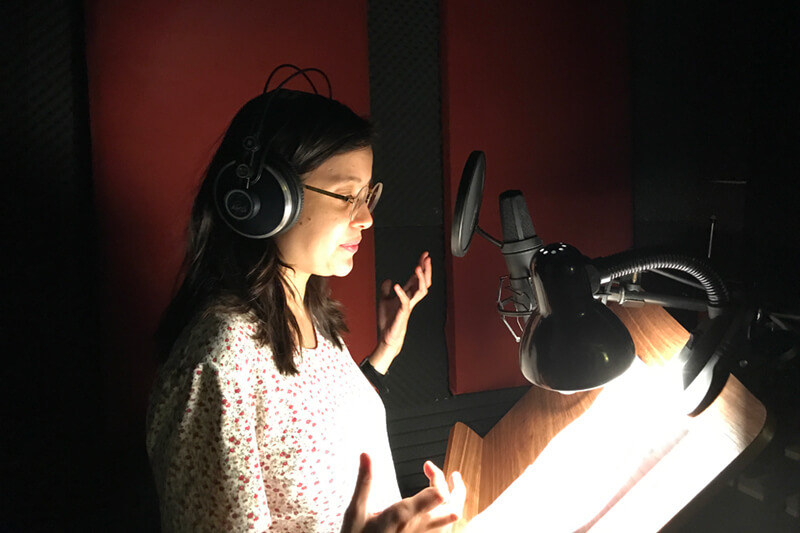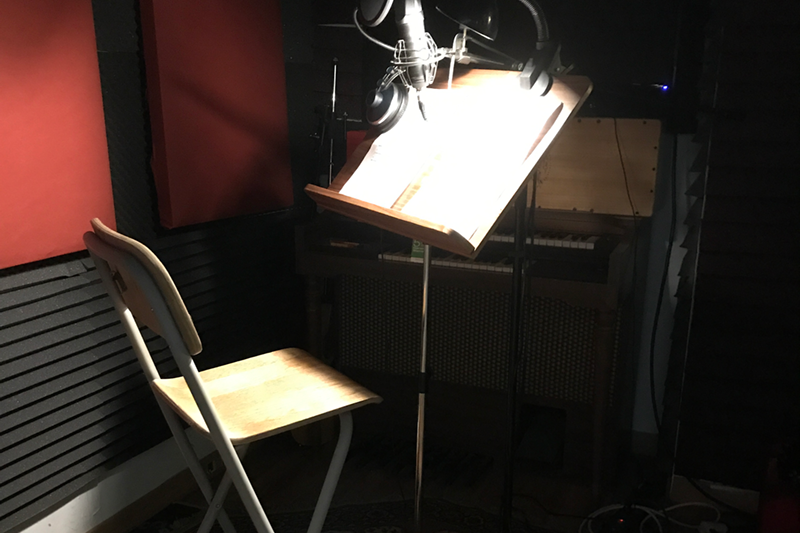Why your company needs a human voice
Voices are an invisible but crucial part of our personalities. Listen to how the voice of Typeform gets conversations started with customers.<br>

It was my second day at Typeform as a Content Producer, and my boss already had special plans for me. The Marketing team was working on a promotional video, and they needed a voice. I happened to be available in the afternoon.
I had no idea what I was doing, and the first takes were awkward. I’m Canadian, and I can’t sound smooth and relaxed when I’m not.
Much to my disbelief, everybody loved it. Except for me, of course. I think I sound like a fifteen-year-old kid. When I answer the phone at my parents’ house, strangers still sometimes ask if they can speak to my “daddy.”
Still, more voice-over projects came, and I humbly accepted them. I even started to enjoy my time behind the microphone.
One day, my colleague Terrence joked that people were now calling me “the voice of Typeform.” Two years later, I still can’t say that I’m comfortable with this.
But the fact that we decided to give a human voice to our company isn’t coincidental. Because a human voice, I believe, is the start of a genuine conversation.
Audio killed the video star
According to some, we’re living in the golden age of audio. One in four Americans listen to podcasts—44% of them millennials. Natural speech recognition has now made its way into our daily lives thanks to Siri and Alexa, and audio book sales are still going up.
Why the surge in popularity? Part of it’s due to improvements in technology. But I think there’s more to it.
For one, digital channels can feel so cold and distant.
In some ways, the act of listening to a recorded human voice is a conversation in itself—one that we initiate by pressing ‘play’ on our devices. Then it’s up to the listener to continue the conversation—by reaching out with questions, buying the product, or listening to the next episode.
Examples of this are plenty.
As an avid listener of This American Life, I often find myself experiencing deep sympathy just a few minutes into the podcast. There’s something visceral about this kind of reporting, how the intricacies of time and place are so efficiently transposed through audio.
Another powerful case is The Moth, a live storytelling event founded in New York City more than twenty years ago. It now exists as a podcast—where millions of listeners can hear real-life stories told by strangers in packed venues across the country. If you close your eyes, it’s like you’re there with them.
Voice-over is also still extensively used in cinema and advertising, and rightly so—it’s a highly effective way to initiate a conversation with a potential customer.
In fact, voices are a central component to any story—some even argue that silent reading has never existed. Whenever we read, we do so with a voice inside our heads. You’re probably hearing a voice echo as you read these lines.
So if we really want our audience to respond, we need to get the voice right.
Voice-over as performance
I recently sat down to listen to all the audio I’ve recorded for Typeform over the past couple of years. While it’s never pleasant to hear the sound of your own voice, I was struck by how vivid my recollections of the recordings were.
Want to hear Valerie’s voice in action? Here’s one of our favorites:
When I heard my voice trailing away, I remembered how tired I was that morning in the studio. In another recording, I got a chuckle out of how grumpy my voice sounded.
By letting these natural imperfections hit the airwaves, voice-over becomes a kind of performance. And it really feels that way too.
We always record in the morning, so my voice sounds fresh. We use a studio located in a small neighborhood on the edges of Barcelona. My time there can be quite meditative. And when the microphone is turned on, I try to imagine explaining the script to a good friend sitting across from me—as if we were having a simple conversation.
This may sound easy, but in practice it’s not. Finding a natural voice that listeners relate to doesn’t happen just by showing up and reeling off a script.
Fittingly, I’ve dedicated much of my adult life to theatre. At acting school, you’re told that your body is a tool of expression, and that every part of it needs to be trained. It’s part of connecting with the audience, inviting them to hop on board as we experience stories together.
Voices also need to be trained. So I reached out to Esther Pallejà, a voice coach based in Barcelona. Here’s what she taught me:
So learning to control your voice is a part of establishing trust as a conversation unfolds.
I also learned to control my nerves and increase voice presence—using physical theatre techniques such as deep breathing exercises, throwing my head upside down, exaggerating sighs and yawns.
That said, we still can’t entirely control when this perfect intonation will come out. But I know that training, and patience, will help me get there.
Turning conversations into customers
Some months ago, the Customer Success team sent out this survey to our customers , to find out how we could best teach them about Typeform. The most common request was video tutorials.
To continue this conversation, I was offered the role of Video Educator, which I happily accepted.
When we launched the new version of Typeform, we decided to offer introductory webinars to our current customers to help them get their bearings. The webinars included a 10-minute video presenting the new platform—narrated and edited by me.
Nearly 1,500 people attended these webinars, and they responded by rating them an 8 out of 10. Lots of people told us they learned a lot, which was our main objective.
I also did the voice-over for a Typeform YouTube ad last summer. So far, it’s had over 650,000 views, and more than 400 people have responded by converting. According to Jake, our head of Performance Marketing, the ad has been performing very well.
But the success of voice-over isn’t so easy to measure.
One big reason for this is that a voice-over doesn’t exist on its own. Great audio or video also owes a lot to great editing, or a very compelling script.
And it’s true that voice isn’t always necessary to tell a story—many people on Facebook and YouTube watch ads without even switching on the audio.
Still, I believe that a good voice-over brings a human, conversational element to the table.
What does your voice sound like?
A good voice starts a conversation. At first one human speaks and the other listens. And if you’re speaking to the right people with an appealing message, they’ll reach out to you to continue the conversation.
But beyond this, it carries on the age-old tradition of storytelling, where reading was traditionally done out loud to educate and entertain others.
A human voice makes people think, empathize, and feel closer to the authors of a message.
And my voice might be the first human interaction that someone experiences with Typeform. So tomorrow, when I record yet another script, I’ll have ginger tea with honey, just in case.
Got a conversation you’d like to have with your customers? Get started here.






